| Description |
FR194738 free base is a squalene epoxidase inhibitor. FR194738 inhibits squalene epoxidase activity in HepG2 cell homogenates with an IC50 of 9.8 nM.
|
| Related Catalog |
|
| Target |
IC50: 9.8 nM (squalene epoxidase, in HepG2 cell homogenates)[1]
|
| In Vitro |
In intact HepG2 cells, FR194738 concentration-dependently inhibits the incorporation of [14C]acetate into free cholesterol and cholesteryl ester, with IC50s of 4.9 and 8.0 nM, respectively. FR194738 induces intracellular [14C]squalene accumulation. FR194738 increases the incorporation of [14C]acetate into squalene, an intermediate of cholesterol synthesis[1]. FR194738 potently inhibits squalene epoxidase (SE) in HepG2 cell homogenate and liver microsomes in dogs and rats. The inhibitory effect of FR194738 in comparison to the HMG-CoA reductase inhibitors, Simvastatin, Fluvastatin and Pravastatin, on cholesterol biosynthesis in HepG2 cells is examined. Among these compounds, FR194738 is the most potent, with an IC50 of 2.1 nM. The IC50s of Simvastatin, Fluvastatin and Pravastatin are 40, 28 and 5100 nM, respectively[2]. FR194738 inhibits hamster liver microsomal squalene epoxidase activity in a concentration-dependent manner with an IC50 of 14 nM[3].
|
| In Vivo |
Serum lipid levels in hamsters after daily administration of FR194738 and Pravastatin for 10 d are measured. FR194738 reduces the serum levels of total, non high density lipoprotein (HDL) and HDL cholesterol, and triglyceride. Treatment of hamsters with FR194738 increases HMG-CoA reductase activity by 1.3-fold at 32 mg/kg compared to the control group and does not significantly change that at 100 mg/kg[3].
|
| Cell Assay |
HepG2 cells are grown in 225 cm2 culture flasks, and incubated for 18 h in medium A containing 10% human lipoprotein deficient serum and 1 μM L-654,969 to increase their squalene epoxidase activity. The HepG2 cells are washed and harvested by trypsin treatment. After centrifugation (1000×g, 5 min at 4°C), the supernatant fraction is removed by aspiration. The cell pellet is frozen and kept at -80 °C until use. On the day of the experiment, the stocked cell pellet is thawed, ruptured by sonication (5 s at 4°C) in 0.1 M Tris-HCl, pH 7.5 containing 1 mM EDTA, mixed with one-fourth volume of 2% Triton X-100, stood at 4°C for 30 min, and assayed for squalene epoxidase activity with some modifications. Aliquots of the mixture are incubated for 90 min at 37 °C with or without test compound (FR194738; 0.01 nM, 0.1 nM, 1 nM, 10 nM, 100 nM, 1 μM, and 10 μM) dissolved in DMSO (final 1%) in a final volume of 0.3 mL containing 0.1 M Tris-HCl, pH 7.5, 1 mM EDTA, 1 mM NADPH, 0.1 mM FAD, 0.3 mM AMO1618, an inhibitor of 2,3-oxidosqualene cyclase, 0.17% Triton X-100, and 8 μM [3H]squalene (3.7 kBq) dispersed in 0.075% Tween 80. The reaction is stopped by the addition of 0.3 mL of 10% ethanolic KOH. After incubation for 90 min at 75°C, non-saponifiable materials are extracted with 2 mL of petroleum ether. The extracts are evaporated under a nitrogen stream. The residue is taken up in a small volume of diethylether, spotted on a silica gel thin layer chromatography (TLC) plate and developed in benzene/ethyl acetate (99.5:0.5, v/v)[1].
|
| Animal Admin |
Hamsters[3] Six-week-old male golden Syrian hamsters (70-110 g) are used. Drugs are administered as a diet mixture for 10 d. Blood samples are collected via heart puncture under ether anesthesia and serum is prepared by centrifugation. The dose of 0.32% in diet corresponds to 127 and 116 mg/kg/d for FR194738 and Pravastatin, respectively, calculated from body weight and food intake.
|
| References |
[1]. Sawada M, et al. Effect of FR194738, a potent inhibitor of squalene epoxidase, on cholesterol metabolism in HepG2 cells. Eur J Pharmacol. 2001 Nov 9;431(1):11-6. [2]. Sawada M, et al. Synthesis and biological activity of a novel squalene epoxidase inhibitor, FR194738. Bioorg Med Chem Lett. 2004 Feb 9;14(3):633-7. [3]. Sawada M, et al. Inhibition of cholesterol synthesis causes both hypercholesterolemia and hypocholesterolemia in hamsters. Biol Pharm Bull. 2002 Dec;25(12):1577-82.
|
